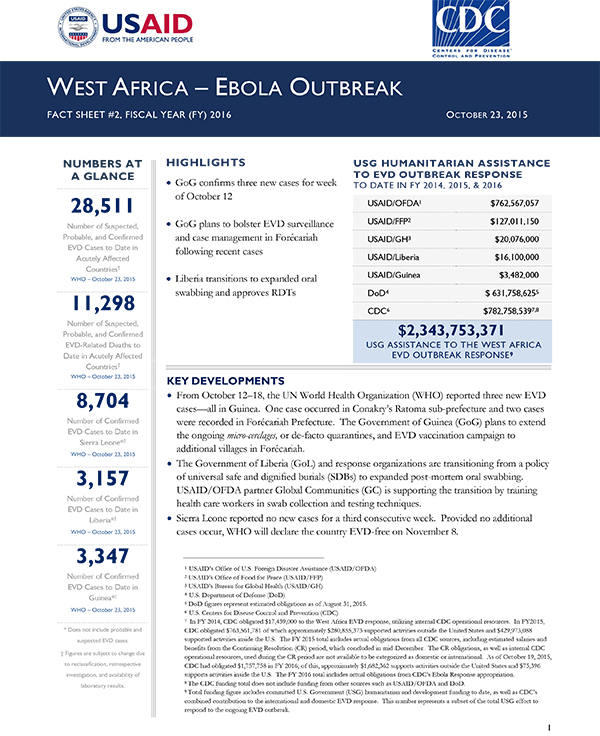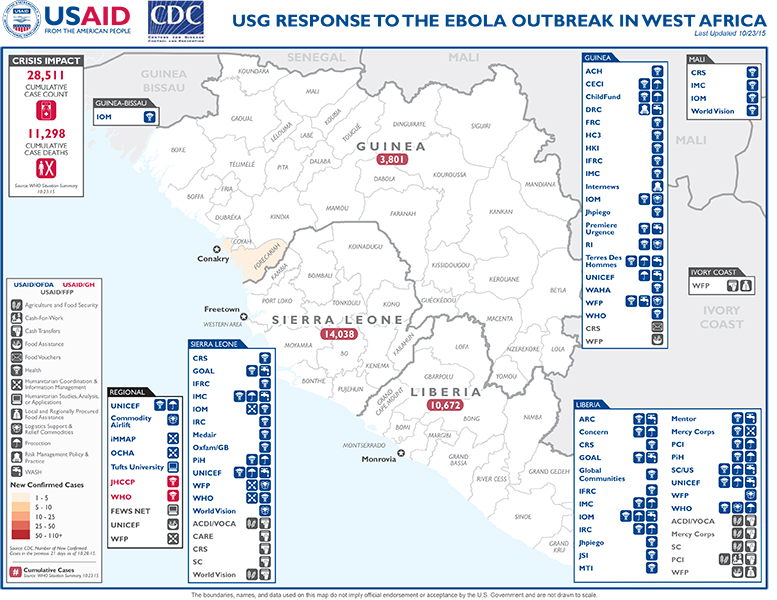Speeches Shim
October 23, 2015
HIGHLIGHTS
Ebola Response
Visit our main West Africa Ebola Outbreak page to learn more about how we're responding to the West Africa Ebola outbreak, and what you can do to help.
- Government of Guinea (GoG) confirms three new cases for week of October 12
- GoG plans to bolster EVD surveillance and case management in Forécariah following recent cases
- Liberia transitions to expanded oral swabbing and approves RDTs
KEY DEVELOPMENTS
West Africa Fact Sheet #2 - 10-23-2015 ![]() (pdf - 382k)
(pdf - 382k)
- From October 12–18, the UN World Health Organization (WHO) reported three new EVD cases—all in Guinea. One case occurred in Conakry’s Ratoma sub-prefecture and two cases were recorded in Forécariah Prefecture. The Government of Guinea (GoG) plans to extend the ongoing micro-cerclages, or de-facto quarantines, and EVD vaccination campaign to additional villages in Forécariah.
- The Government of Liberia (GoL) and response organizations are transitioning from a policy of universal safe and dignified burials (SDBs) to expanded post-mortem oral swabbing. USAID/OFDA partner Global Communities (GC) is supporting the transition by training health care workers in swab collection and testing techniques.
- Sierra Leone reported no new cases for a third consecutive week. Provided no additional cases occur, WHO will declare the country EVD-free on November 8.
Liberia
During active EVD transmission in Liberia, the GoL instituted a policy mandating universal SDBs conducted by trained burial teams in strict compliance with national protocols. Now in a 90-day period of enhanced surveillance—with all counties except Montserrado and Margibi free of known EVD transmission for more than 270 days—the GoL and response organizations are revising dead body management policies, transitioning to a prioritization of oral swab collection over SDBs.
In the new phase, trained staff from funeral homes and health facilities and trained environmental health technicians (EHTs) will collect oral swabs for laboratory testing following suspicious deaths. To support the transition efforts, USAID/OFDA partner GC trained 21 EHTs in six southeast counties in late August and 20 EHTs in three central counties at the beginning of October, with plans to train an additional 22 southeast and central EHTs in early November. All nine counties targeted have already deactivated their SDB teams. Additionally, GC reports a reduction of SDB teams in Grand Cape Mount, Gbarpolu, Lofa, Margibi, and Nimba counties at the end of October, with plans to train 29 EHTs on October 28. EHT trainings at the district and zonal levels of Montserrado County are scheduled for October 21–23, with a planned reduction to four modified SDB teams on October 31.
As of October 6, the Liberian Institute for Biomedical Research Ethics Committee had approved the use of OraQuick EVD rapid diagnostic tests (RDTs) in Liberia. The GoL plans to pilot the use of RDTs in Margibi and Montserrado counties in the coming weeks. EVD response actors anticipate that the expanded use of RDTs—which provide results within approximately 20 minutes—will reduce the number of samples sent to laboratories, thereby reducing turnaround time and laboratory backlog.
West Africa Map - 10-23-2015 ![]() (pdf - 531k)
(pdf - 531k)
Sierra Leone
USAID/OFDA continues to support the International Medical Corps (IMC)-managed EVD treatment unit (ETU) in Kambia District due to the potential for cross-border transmission via cases in Forécariah, Guinea. At the same time, USAID/OFDA is prioritizing the development of EVD care capacity at local health facilities as part of the response-torecovery transition in Sierra Leone.
With USAID/OFDA support, GOAL is constructing 90 semi-permanent isolation units in Bombali District to enhance the transition of EVD response activities to local institutions and to transfer triage and care capacity to community health authorities. The District Health Management Team (DHMT) and local authorities in Bombali approved the design and location of the isolation units; as of October 13, GOAL had completed 89 units, including 67 units with two-bed capacity for health posts and 23 units with four-bed capacity for community health centers. The isolation units are suitable for use in a potential EVD re-emergence, as well as for the treatment of other communicable diseases.
On October 12, the USG Disaster Assistance Response Team (DART) travelled to Kambia with CDC and USAID/GH counterparts to observe and monitor ongoing USAID/OFDA programs and discuss response-to-recovery transition plans with partners and local authorities. The DART visited the International Organization for Migration (IOM)- managed Mange checkpoint, which records approximately 1,000 people crossing between Port Loko and Kambia districts per day, the Gbalamuya formal border-crossing point between Sierra Leone and Guinea, where up to 1,500 people cross per day, and the Kalamba unofficial crossing point, which records up to 50 people crossing per day. The DART also observed the IOM population flow monitoring teams, which operate 12 hours per day to record and compile basic demographic data to track and analyze population flow patterns. IOM’s border monitoring and population flow mapping program continue to be an integral component of the EVD response, particularly given the fluidity of border communities.
IOM, with USAID/OFDA assistance, is supporting EVD screening and infection prevention and control (IPC) training, mentoring, and monitoring in government hospitals throughout the country. Following a CDC assessment in Western Area that identified nearly one-third of 170 private clinics as lacking adequate IPC measures, IOM will begin supporting IPC training at 48 identified private clinics, collaborating with the MoHS to coordinate clinic participation. Through UK Department of International Development support and in collaboration with IMC, IOM also plans to conduct IPC trainings at private hospitals in Western Area Urban and Rural, Bo, Kenema, and Moyamba districts. In addition to IPC training, the project includes basic water, sanitation, and hygiene assessments and interventions and a three-month supply of IPC materials.
Guinea
The GoG confirmed three new EVD cases during the week of October 12–18, including a 21-year-old male from Conakry’s Ratoma sub-prefecture who tested positive for EVD on October 13 and two cases from Forécariah Prefecture. According to CDC, the man from Ratoma became symptomatic on October 8. After testing positive for malaria using a RDT, his brother-in-law—an EVD survivor discharged from the ETU at Conakry’s Donka Hospital in December 2014 and currently employed at the MSF-managed Nongo ETU—treated him for malaria. Following the deterioration of his health, the case travelled by taxi to the Nongo ETU.
On October 14, the GoG confirmed a new case in Forécariah’s Kaliah sub-prefecture. The case, a 35-year-old female, became symptomatic between October 8–10 and died at home on October 13 after visiting one of the traditional healers and an assistant who both tested positive for EVD on September 26–27. A post-mortem swab confirmed that the woman was EVD positive. As a measure of precaution, EVD response actors immediately transferred her three-monthold child, who was being breastfed at the time and considered high-risk, to the Nongo ETU. On October 16, diagnostic test results confirmed that the infant was also EVD-positive.
During the October 19 National Ebola Coordination Cell meeting, EVD response actors expressed concern regarding the failure to detect the October 14 case in Kaliah, particularly given the ongoing micro-cerclages in nearby villages. To reinforce active EVD case detection and surveillance in the sub-prefecture, the GoG plans to extend the micro-cerclage and vaccination campaign to 55 satellite villages in the coming days. CDC is also urging that health care workers exercise increased vigilance when processing symptomatic individuals.
USAID/FFP recently provided Catholic Relief Services (CRS) with an additional $1.9 million to expand and extend the provision of food vouchers to people in the EVD-affected prefectures of Macenta and N'Zerekore. CRS also plans to assist beneficiaries restore livelihoods and productive assets lost during the EVD crisis by providing livelihood vouchers and organizing livelihood fairs. The new programming targets approximately 10,000 people.
PUBLIC DONATION INFORMATION
- The most effective way people can assist relief efforts is by making cash contributions to humanitarian organizations that are conducting relief operations. A list of humanitarian organizations that are accepting cash donations for disaster responses around the world can be found at www.interaction.org.
- USAID encourages cash donations because they allow aid professionals to procure the exact items needed (often in the affected region); reduce the burden on scarce resources (such as transportation routes, staff time, and warehouse space); can be transferred very quickly and without transportation costs; support the economy of the disaster-stricken region; and ensure culturally, dietary, and environmentally appropriate assistance.
More information can be found at:
- The Center for International Disaster Information: www.cidi.org or +1.202.821.1999.
- Information on relief activities of the humanitarian community can be found at www.reliefweb.int.
USAID/OFDA bulletins appear on the USAID website at what-we-



Comment
Make a general inquiry or suggest an improvement.